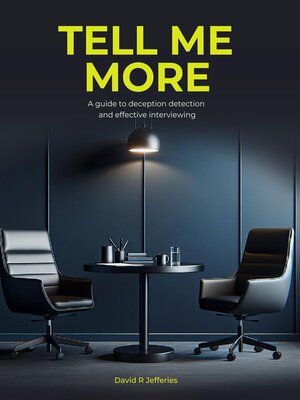
Sign up to save your library
With an OverDrive account, you can save your favorite libraries for at-a-glance information about availability. Find out more about OverDrive accounts.
Find this title in Libby, the library reading app by OverDrive.



Search for a digital library with this title
Title found at these libraries:
| Library Name | Distance |
|---|---|
| Loading... |
This book has three parts. The first part examines deception detection. It looks at lies, lying and liars but also delves into language construction, emotions, physiology, psychology, and more. It explains how microexpressions and statement analysis are reliable deception detectors. It describes how, on their own, the clues and signs of deception are not lie detectors but indicators of deceptive behaviour and speech. Like any forensic tool, it is not what they tell you but what that information can mean in the correct context. A fingerprint on a knife does not, on its own, provide evidence that the fingerprint belongs to the murderer, but only that a particular fingerprint is present on that knife. As we require more proof regarding the knife (what other forensics are present, whose fingerprint it is, etc.), we need more deception indicators beyond a simple choice of word, a flash of emotion, or a physical gesture.
The second part discusses microexpressions and statement analysis, the twin tools in reliable deception detection. Both provide valuable clues of deception through the language and vocabulary used by a person, as well as those flashes of emotion and physical gestures that reveal much more than they are telling us directly. We will also look at the history and science behind both and how they have become standard practices for law enforcement worldwide. After all, why should such practical techniques be solely for law enforcement?
The third part deals with the interview and examines why interviews are conducted. It looks at the similarities and differences in interview types. It explains how a common approach is the best way to ensure that interviews are successful, productive, and meet their objectives. It is a stand-alone topic and represents time well spent adopting and perfecting the approach detailed in the section.
Finally, we will draw it all together and show how this will ensure your interviews are carried out efficiently. By adopting the practices, models and techniques described in this book, you will be so much better placed to ensure that, whatever reason you interview, you will ensure your interviews get results you can rely on that will enable you to make better decisions and draw more correct conclusions with confidence - whether that result is appointing the right person to a role, identifying which staff member is telling the truth, or working out before your partner that the daughter brought Sir John Somebody to an early demise in the new crime series on Netflix.
Take what is helpful to you from this volume. It is written so that you may start at the beginning and read through until the end, but it is also intended for those with specific requirements. Feel free to jump to any part that interests you and dip in and out as you wish. But whatever you do, enjoy the content for what it is - an insight into interviewing and deception detection. I do not doubt that once you embrace the concepts and practices within these pages, you will find yourself more at ease in interviews and achieving much better outcomes, whether you are the interviewer or the interviewee.







